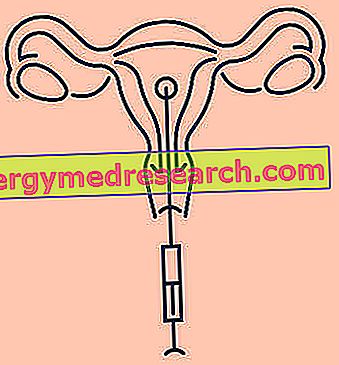Generality
Yellow diarrhea is a symptom that is manifested by the rapid emission of abundant watery or liquid stools, yellowish or mustard in color. This disorder is found rather rarely.

Yellow diarrhea usually indicates an accelerated transit through the gastrointestinal tract or reduced digestion of fats ingested with food.
If diarrheal discharges do not tend to regress within a day or two, this could be the cause of more serious disorders.
The diagnostic path includes the collection of anamnestic data, the analysis of the characters with which the yellow diarrhea occurs and the performance of instrumental and laboratory tests.
The treatment is aimed at the triggering cause and may include various interventions, such as changes in diet or the use of specific drugs.
Did you know that…
- As a rule, the color of the stools is brown, more or less dark, although it may vary depending on the digested foods. This characteristic is mainly due to the presence of bile pigments . The natural color of the faeces is due, in particular, to the bilirubin secreted by the liver, preserved in the gallbladder, and then introduced into the intestine.
- At the intestinal level, bilirubin is transformed first into urobilin, then into stercobilin by the intestinal bacterial flora: it is this latter substance which gives the faeces its characteristic brown color.
- The color of the stools is a signal of the state of health not only of the digestive tract, but also of the organs involved in the digestive process: liver, pancreas and gallbladder .
What's this
Yellow diarrhea is a symptom which consists in the emission of abundant little formed stools (liquid or semi-liquid), expressed with at least three evacuations a day .
This defecation disorder is found predominantly as an expression of pathological problems and / or conditions affecting the gastrointestinal tract .
Sometimes, yellow diarrhea is due to completely occasional changes related to taking certain medications, eating or stress . In other cases, diarrheal discharges can be repeated frequently or for a prolonged period of time, signaling the presence of more severe disorders, characterized by a difficulty in digestion.
Among the conditions that may be associated with this symptom are some liver diseases (such as various types of hepatitis), pancreas (eg chronic pancreatitis) and biliary tract (including gallbladder stones, cholecystitis and biliary cirrhosis). This manifestation is also observed in malabsorption syndromes .
Causes
Yellow diarrhea is not a disease, but a generic symptom that can occur in many conditions, almost always gastrointestinal. Often, this manifestation is an indication of some pathologies involving the small intestine, the liver, the pancreas and the gallbladder.
Yellow diarrhea may occur occasionally ( acute form ) or for a prolonged period of time ( chronic form ).
Diseases of gallbladder, biliary tract and liver
Yellow diarrhea may indicate the presence of obstructive problems, which prevent the bile from reaching the intestine. Consequently, the reduced quantity of bile salts (essential for the digestive process) that reaches the intestine can cause a bad digestion of the fats ingested with the diet, which are expelled as they are.
Therefore, yellow diarrhea can be a symptom of gallbladder diseases, such as:
- Gallstones (these concretions may form, for example, as a result of cirrhosis or blood disorders);
- Cholecystitis (gallbladder inflammation);
- Inflammation of the bile duct (cholangitis), caused by bacterial infections or gall bladder stones;
- Primary sclerosing cholangitis (intrahepatic or extrahepatic bile duct disease, supported by chronic inflammation);
- Biliary cirrhosis;
- Cysts located in the bile ducts;
- Atresia, fibrosis or stenosis of the biliary tract;
- Cholangiocarcinoma (bile duct cancer).
An insufficient excretion of bile may also depend on liver disease .
In particular, yellow diarrhea can occur in the event of:
- Inflammation of the liver (hepatitis);
- Hepatic cirrhosis;
- Jaundice secondary to an increase in bilirubin (this condition occurs in people who have liver problems or suffer from a form of hepatitis);
- Liver tumor.
Yellow diarrhea may also depend on pancreatic disease, such as:
- Pancreatitis;
- Some cancers;
- Congenital insufficiency of lipase synthesis (enzymes secreted in the intestine, with which the pancreas participates in the digestion of fats).
In this case, diarrheal discharges are smelly and oily due to the considerable quantity of unassimilated fat (steatorrhea).
Intestinal disorders
Yellow diarrhea can be seen as an expression of problems in the small intestine that involve an increase in the speed of food transit and / or a difficulty in digestion.
These conditions include inflammatory bowel diseases, including:
- Irritable bowel syndrome;
- Ulcerative colitis;
- Crohn's disease.
Yellow diarrhea can also occur in pathological states that interfere with normal absorption of nutrients during digestion, such as celiac disease (or celiac disease) and other malabsorption syndromes .
In some cases, yellow diarrhea can also be observed in the presence of gastroesophageal reflux disease (GERD), which can cause the body to digest food at a faster rate than normal.
Infections
Yellow diarrhea may depend on bacterial, viral and parasitic infections of the gastrointestinal tract, such as:
- Gastroenteritis;
- Whipple disease (a disease caused by chronic infection by the bacterium Tropheryma whipplei which causes severe malabsorption);
- Giardiasis (infectious disease that is contracted from contaminated waters, responsible for a violent yellow diarrhea);
- Tuberculous enteritis;
- Mononucleosis;
- Yellow fever.
Other causes
If prolonged over time, yellow diarrhea can be a symptom of cystic fibrosis, food intolerances (such as lactose) and colon cancer.
Symptoms and Complications
The yellow diarrhea manifests itself with the evident alteration of the color of the excrements. This symptom may occur, depending on the underlying cause, as a sporadic manifestation (associated with a single episode), continuous or recurrent (it takes until the underlying pathology is resolved).

Possible associated disorders
Depending on the cause, the yellow diarrhea can be accompanied by other symptoms that affect the intestine and the digestive tract.
Among the most common we can find:
- Tenesmus (continuous urge to defecate), even in the absence of faeces.
- Fatigue;
- Swelling;
- Loss of appetite;
- Nausea and vomit;
- Acute abdominal pains;
- Widespread itching;
- Jaundice (yellowing of the sclerae and skin).
Complications of yellow diarrhea
Yellow diarrhea, if profuse or repeated, in addition to water loss, also causes the loss of proteins and mineral salts (in particular: sodium, chlorine, bicarbonate and potassium) which are normally reabsorbed along the intestine.
The consequences include imbalances in the salt and water balance, dehydration and / or metabolic acidosis with hypotension, decrease in diuresis, numbness and tachycardia.
Diagnosis
In the event that the yellow diarrhea is prolonged (over a couple of days) or recurrent (that is, it is repeated frequently alternating with periods with solid stools), it is necessary to consult your doctor, for a clinical evaluation .
The diagnostic procedure includes the anamnesis, the objective examination of the patient and the analyzes of the blood and urine. In the evaluation of this symptom are useful, then, the chemical-physical exams (malabsorption), culture (bacterial infection) and parasitological examinations of faecal material.
To establish the causes responsible for the yellow diarrhea and prescribe the appropriate therapy, the doctor can also indicate the execution of:
- Esophagogastroduodenoscopy (EGDS) : endoscopic examination that allows the visualization of the inside of the esophagus, stomach and duodenum;
- Colonoscopy : allows to examine the inside of the colon, identifying polyps or cancerous lesions;
- CT or MRI : imaging studies useful to highlight some neoplastic lesions.
Treatment and Remedies
Regarding treatment, the options vary depending on the specific cause that led to the appearance of yellow diarrhea. When the symptom occurs sporadically, it should not be a cause for concern and, often, it is not necessary to resort to special care.
Other times, however, yellow diarrhea may be an indication of diseases that require targeted treatments for their resolution. If discharges are very frequent, antidiarrheal drugs can be used, bearing in mind that these do not cure the disease, but are only symptomatic of yellow diarrhea. Furthermore, these medicines have side effects, so it is best to consult your doctor before taking them.
Dietary measures
To solve the problem of yellow diarrhea, the doctor, in addition to indicating the most correct therapeutic protocol, can advise the patient to adopt a "blank" diet, with poorly seasoned foods. In mild or acute forms, in addition to replenishing lost fluids, it is advisable to have an astringent diet regime (carrots, lemon, rice, boiled chicken and fish, grilled lean meat, etc.) and limit the intake of fiber-rich foods. tea, coffee, spirits and dairy products.
Furthermore, in the case of yellow diarrhea, the doctor can advise taking lactic ferments to regulate intestinal functions, through the normalization of the bacterial flora.
In severe cases, care must be taken to prevent or correct dehydration . Therefore, it is necessary to replenish liquids, mineral salts and lost sugars, through foods, electrolyte solutions or infusion.



